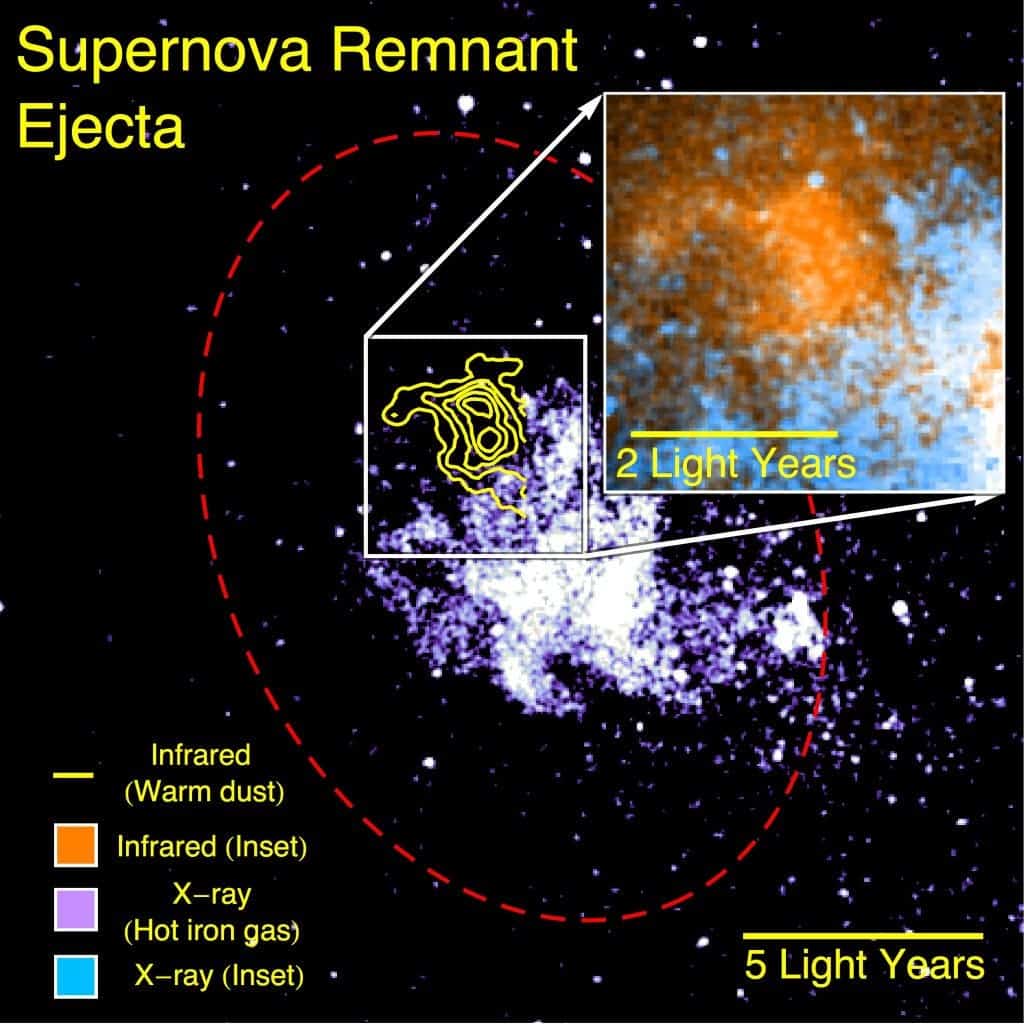Everything is made of stardust – but some things are made of more stardust than others. A new study has found that a single supernova is capable of producing large enough quantities of dust to lead to the creation of thousands of planets like Earth.

Supernova remnant dust detected by SOFIA (yellow) survives away from the hottest X-ray gas (purple). The red ellipse outlines the supernova shock wave. The inset shows a magnified image of the dust (orange) and gas emission (cyan). Image Credit: NASA/CXO/Lau et al
An international team of researchers used the NASA and German Aerospace Center’s Stratospheric Observatory for Infrared Astronomy project (SOFIA) to gather and analyze data, gaining new insight not only on supernova evolution, but also on planetary and galactic evolution.
“This discovery is a special feather in the cap for SOFIA, demonstrating how observations made within our own Milky Way galaxy can bear directly on our understanding of the evolution of galaxies billions of light years away,” said Pamela Marcum, one of the researchers.
Supernovae are amazing manifestation of energy – for brief moments, a supernova can outshine an entire galaxy, radiating as much energy as the Sun or any ordinary star is expected to emit over its entire lifespan, before fading after a few weeks or months. Supernovae form are basically stellar eruptions, triggered either by the gravitational collapse of a massive star, or by sudden re-ignition of nuclear fusion in a degenerate star.
In a study published Thursday in Science, researchers led by Cornell postdoctoral associate in astronomy Ryan Lau made observations on the ejected dust from a supernova, using SOFIA in an attempt to quantify the dust.
“Our observations reveal a particular cloud produced by a supernova explosion 10,000 years ago contains enough dust to make 7,000 Earths,” said Ryan Lau of Cornell University in Ithaca, New York.
SOFIA currently sits on a modified Boeing 747SP jumbo jet, which was actually very important for this study.
“We were on a flying observatory traveling at 600 mph (965 km/h) at an altitude of 45,000 feet (13,715 meters) to take images of a 10,000-year-old supernova remnant located 27,000 light-years away from us at the center of our galaxy,” Lau told Space.com. “No other currently operating observatory other than the Stratospheric Observatory for Infrared Astronomy could detect this dust.”

SOFIA data reveal warm dust (white) surviving inside a supernova remnant. The SNR Sgr A East cloud is traced in X-rays (blue). Radio emission (red) shows expanding shock waves colliding with surrounding interstellar clouds (green).
Image Credit: NASA/CXO/Herschel/VLA/Lau et al
There were already solid indications that supernova explosions produced significant amounts of dust, but it was not clear just how much, nor was clear whether or not the dust can withstand the “rebound” shock wave generated when the first, outward-moving shock wave collides with surrounding interstellar gas and dust. The answer turned out to be positive – this means that the dust could actually move on to become the “seed” of planetary formation.
“The dust survived the later onslaught of shock waves from the supernova explosion, and is now flowing into the interstellar medium where it can become part of the ‘seed material’ for new stars and planets,” Lau explained.
For more information about SOFIA, visit: http://www.nasa.gov/sofia









